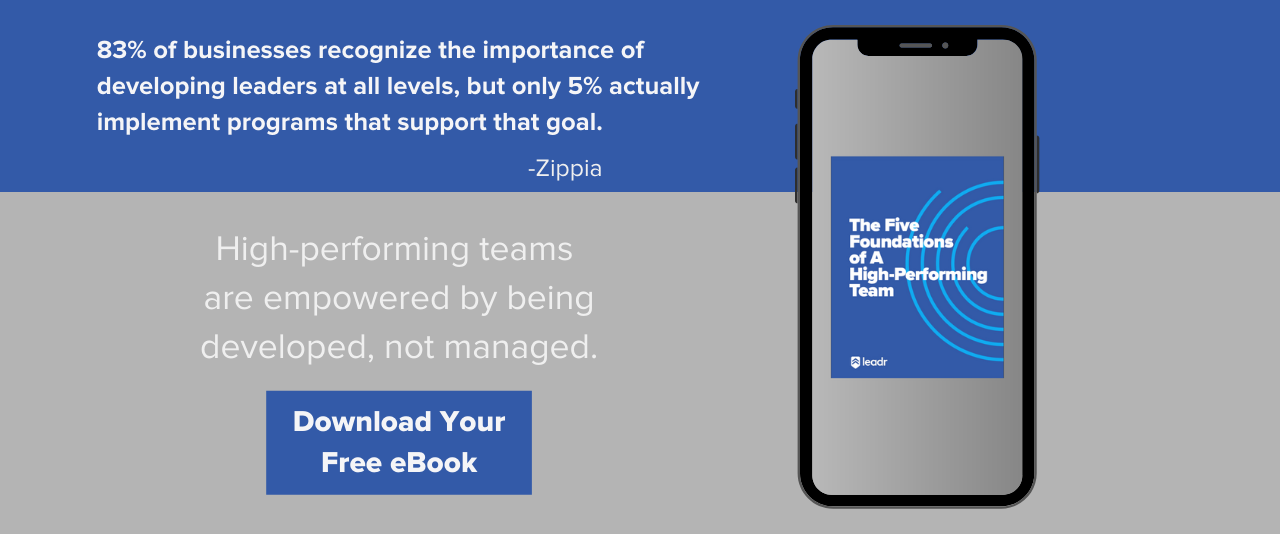Measuring the ROI of Employee Development
A comprehensive collection of statistics to illustrate the importance of investing into your employee development program.
Failure to invest in people development will cost you. Employee development is a critical strategic tool for nurturing productivity and retention so that companies can grow in a competitive landscape. Investing in employee development is about protecting the company’s most valuable asset – its human talent – to stay ahead of the skills shortages and advance innovation.
Quantifying the return on investment (ROI) in employee development is often an elusive task. The intangible results make it difficult to irrefutably prove whether the effort, time and money spent have actually netted a worthy result. Many wrongly equate success with being able to recoup the financial investment to justify the expense. The reality is that there are many tangible and intangible costs and returns, each of which is unique to your organization.
When weighing ROI, consider these questions:
-
What is the drain on profits when 25% of your staff comes to work with a low level of engagement?
-
How much did it set you back financially and in lost time when the last employee suddenly resigned or was terminated?
-
How much could you have saved by developing an internal employee instead of hiring an outsider for the last executive role?
-
Are there intangible costs that impact customer satisfaction, such as poor guest experiences, due to disengaged employees who lack soft skills development?
Taking all of these factors into consideration, it’s clear that a lack of employee development will cost you. The question is how much? To help you answer that question, we’ve pulled key statistics from each of the six primary areas of employee development.
Use the statistics and modify them to your organization to calculate an approximate return on investment. For example,
-
The Statistic: “Highly engaged teams produce at 21% greater profitability across industries, company size, location and economic conditions.”
-
Customize it to your organization: Our current profitability margin is _____. If it were to increase by 21%, then it would mean $______ more revenue.
-
Divide that by the cost of your people development software or training program to get your approximate return on investment
Ultimately, whether it’s purely a numbers calculation, or if your goal is to create an organizational culture that fosters growth and improvement regardless of the bottomline, you will find the data below to support your decision to invest in employee development.
Take a look at the following statistics that resoundingly support the smart decision to invest in the quality of those people who are shaping the future of your organization.
The ROI of Engagement

The goal of investing in employee engagement isn’t simply to make your workforce happy. From wellness programs and swag bags to flexible working hours and annual getaways, every employee engagement initiative should aim to develop mental and emotional connections to the workplace. Investment in employee engagement pays dividends when everyone on the team is passionate about their jobs, clear on their priorities and motivated by the mission as well as given opportunities to maximize their strengths and operate with a high level of trust, respect and rapport with their colleagues.
See below for evidence on the ROI of employee engagement programs:
-
Highly engaged teams produce at 21% greater profitability across industries, company size, location and economic conditions. Organizations and teams are nearly twice as likely to succeed when employee engagement scores reach the top quartile, leading to a 41% reduction in absenteeism and 59% less turnover along with a 17% increase in productivity and a 20% boost in sales.
Source: Gallup, “The Right Culture: Not Just About Employee Satisfaction”
-
A lack of productivity and innovation contributes to disengaged employees costing U.S. companies an estimated $550 billion in potential profits. Among employees’ top reasons for not being fully engaged are poorly designed jobs, mistrust among colleagues and lack of meaningful work. An astonishing 95% recognize when they start feeling disengaged.
Source: The Engagement Institute, “DNA of Engagement: How Organizations Can Foster Employee Ownership of Engagement”
-
While 35% of employees report feeling engaged at work, the highest level yet since tracking began in 2000, that also means two-thirds are wanting something more from their jobs. Those who are not engaged report doing the minimum required, are emotionally disconnected to the company and are ready to move on for an even slightly better offer.
Source: Gallup, “2019 Employee Engagement Survey”
-
Higher engagement in a company is associated with a 24.5% larger share price growth when lower engagement is compared. When employees also believe in the product, share price growth nearly doubles to 51%, and more than half of the companies outperform the Dow Jones Index by two times.
Source: Culture Amp, “The ROI of Employee Engagement and Culture”
-
Building a structured set of foundational elements for growth and development opportunities is what evolves employee engagement to the next level. Weak foundational elements, such as not having the tools to do the job effectively, produce a 31% engagement index. When all the developmental elements are in place, engagement jumps to 74%.
Source: PriceWaterhouseCoopers, “Evolving an Engaging Work Experience”
The ROI of Training

When the successful ROI from training is based solely on its measurable contributions to improving job performance and reaching key organizational goals, then companies miss valuable opportunities to advance their industry position. Traditionally, the majority of training centers on attaining job proficiency and expanding technical skills, but keeping up with recent industry developments and learning new strategies to meet changing organizational needs is what pushes organizations forward. This new knowledge broadens the employee’s understanding and develops their competence to work at a higher level. Companies also excel when they focus on developing soft skills like communication, collaboration, conflict resolution, productivity, organization and adaptability.
Consider this evidence for the ROI of employee training programs:
-
Investment in employee learning is enjoying a seven-year rise with typical spending reaching $1,299 per employee in 2018. Employees engage in an average of 34 hours of continuing education – roughly four workdays – developing their skills, increasing their knowledge and advancing their abilities to strengthen the workforce.
Source: Association for Talent Development, “2019 State of the Industry”
-
With 90% of companies redesigning jobs, and nearly one-third doing so substantially, C-suite executives are wrestling with several pressing workforce issues, including how to transition newly automated jobs into technology-driven roles. Roughly a quarter are looking at ways to “transition to the future of work,” redesigning jobs and reskilling their current workforce. Most believe that bringing in new talent is not the right direction with 77% indicating they would rather train current employees to address these ongoing personnel challenges.
Source: Deloitte, “2019 Global Human Capital Trends”
-
Only 3% of all companies attempt to analyze the results of their employee training program beyond Level 2 of the Kirkpatrick Model. This approach works for measuring content quality and determining how the new information ties to the overall objectives. However, aptitude is demonstrated at level 3 where participants apply the newly acquired knowledge on the job. Performance is best measured at level 4 when the training contributes to the achievement of targeted program outcomes.
Source: Association for Talent Development, “2019 State of the Industry”
-
An estimated 38% of people believe that organizations and employees have equal responsibility for learning and skill development. Nearly half of workers who identified their company as being poorly positioned for success cited co-ownership of professional training as being an issue. This ongoing, significant gap in joint accountability is draining the record-breaking investments in learning as three-quarters of organizations look to strengthen their training programs.
Source: Deloitte, “2019 Global Human Capital Trends”
The ROI of Feedback

The act of giving and receiving feedback is an uncomfortable moment for the majority of people. When delivered infrequently and inconsiderately, feedback feels like criticism, which immediately sends up the walls of defense. However, constructive viewpoints are a vital workplace tool that speeds up learning, increases engagement, improves outcomes and encourages diversity of voice. To realize the potential of this powerful tool for growth and development, managers must engage in frequent, consistent, two-way dialogue that focuses on employees’ strengths and future growth rather than shortcomings and past failures.
These four studies prove a strong ROI for creating a healthy feedback culture:
-
Employees across all age groups and positions value feedback. Of those who self-identify as highly engaged in their jobs, 45% report that weekly feedback is a factor. Companies that implement regular employee feedback also have a 14.9% lower turnover. When managers focus on the employee’s strengths during these interactions, they are 30 times more likely to encourage active engagement.
Source: OfficeVibe, “Statistics on the Importance of Employee Feedback”
-
Colleagues love to give each other feedback and receive it. When peers and managers offer suggestions for improvement and recognition in the moment, 58% of employees say they are motivated to improve their work performance and feel like they are held more accountable. An equal amount reports that everyone at their organization is empowered to offer feedback, but 27% of recognitions are given by managers only and 15% are limited to senior leaders.
Source: Globoforce, “Bringing More Humanity to Recognition, Performance, and Life at Work”
-
Although managers largely agree that negative feedback is harder to give, 1 in 5 say they have a stronger preference for giving it. While 92% of employees agree that negative critiques are effective at improving performance, they only work when delivered appropriately. Doing it right is a learned skill that requires management training on redirecting and many opportunities to practice.
Source: Zenger Folkman, “Why Is It So Difficult for Leaders to Give Positive Feedback?”
-
It is not enough to simply give feedback. You must also gather it – and then actually do something with it. Companies that are identified as being above average on innovation are more likely to have a culture that frequently seeks assessment and responds to employees’ ideas and improvement suggestions. The success surges from 44% among average companies to 78% among high performers.
Source: PriceWaterhouseCoopers, “Evolving an Engaging Work Experience”
The ROI of Coaching

Coaching employees goes beyond managers giving feedback. A coach acts as a sounding board and guides each team member’s career growth, actively finding ways to help them acquire the skills needed to strengthen the group. The coach encourages the worker to see their potential, motivates them to stretch beyond their current role and serves as a model for developing new skills and behaviors.
Consider these reasons for investing in developing a coaching mentality amongst your leadership team:
-
The mean return on investing in leadership coaching was 7 times the initial investment, although more than one-quarter of programs revealed returns ranging from 10% to 49%. Two in 10 recouped more than 50 times the amount they put out.
Source: Forbes, “Executive Coaching – Another Set of Clothes for the Emperor?”
-
Continuous performance management, rather than annual reviews, increases trust between employees and managers with ratings improving from 34% to 41%. Managers are also perceived as better coaches, jumping from a 64% approval rating to 78%.
Source: Globoforce, “Bringing More Humanity to Recognition, Performance, and Life at Work”
-
There is a huge distinction between bossing and coaching. The focus on engagement, the nurturing of strengths and the strategic positioning of talent allows coaches to maximize outcomes and adapt to changing situations. Workers who are aware of their strengths routinely increase their sales by 19% and generate up to 29% more profits.
Source: Gallup, “Give Up Bossing, Take Up Coaching: You’ll Like the Results”
-
Companies that cultivate a coaching culture improve their ability to set goals, and by identifying and leveraging natural strengths, they report higher revenues than industry peers. Of those who have received manager coaching, 80% say their work performance, productivity and communication skills have improved. However, only 36% of new leaders receive training on how to be a good coach.
Source: Association for Talent Development, “Why You Need a Coaching Culture”
The ROI of Goal Setting

Goal setting is a cornerstone of the American workforce for driving growth and measuring progress. But, many organizations find that simply setting a benchmark and measuring attainment does not produce what they really want – clarity, alignment, focus and stretching. When goals are tied to performance evaluations, which are in turn linked to salaries, promotions and other rewards, employees have no incentive to strive for more than what they already know they can achieve. Professional goals that actually work are both self-imposed and offer space for personal growth.
Consider this evidence for the successful ROI of goal setting when each goal is clearly defined, company aligned, widely shared and single-mindedly relevant:
-
Lack of clear priorities and cloudy decision-making processes round out the top five most common work performance obstacles with 21% of employees citing these two issues as problems that derail efforts to improve the workplace experience. Symptoms manifest as regularly doing unassigned work, attending unnecessary meetings and following inefficient processes. These time-wasters drain engagement and indicate that the organization needs to progress from a foundational to a distinctive work experience.
Source: PriceWaterhouseCoopers, “Evolving an Engaging Work Experience”
-
When it comes to goal-setting collaboration, just 3 in 10 employees strongly agree that their managers involve them in the process. Only 2 in 10 talk with their managers about the steps necessary to reach their goals. Those who do are 3.5 times more likely to be engaged in what they consider meaningful work.
Source: Gallup, “3 Reasons Why Performance Wins in the Workplace”
-
When goal setting is part of the annual performance review process, employees are empowered to learn and grow. One critical feature included in 91% of effective performance management systems is the ability for employees to easily link their goals to business priorities. Companies who link organizational business goals to functional business objectives, and then convert them into team-performance goals, witness increases in motivation, accountability and job performance.
Source: McKinsey, “How Effective Goal Setting Motivates Employees”
-
There needs to be a strategy in order to achieve a vision, yet only 7% of employees fully understand how their role contributions to achieving the company's common goals. Additionally, 79% of middle managers and 49% of senior managers do not have personal goals linked to the overall business strategy. The key to implementing strategy is for everyone to understand the direction, align resources and adapt in real time.
Source: Robert S. Kaplan and David P. Norton, "The Strategy-Focused Organization," Harvard Business School Press, 2001
The ROI of Recognition

Reward programs drive company performance when they include more than just ad-hoc or tenure-based recognition. The goal is to drive motivation, which deepens productivity and engagement. Each recognition program should be customized for the organization and team environment, but the best ones develop clear criteria, offer multiple ways to give recognition from all staff levels and provide incentives that employees value.
Here are four compelling reasons for investing in employee recognition programs:
-
In a global survey of 200,000 people, appreciation for work ranked as the most important factor in job satisfaction, far above attractive salary, interesting job content and flexible work models. When good job performance is rewarded with more challenging responsibilities, employees stay engaged, are driven to reach for more and have a stronger rapport with their colleagues and superiors.
Source: Boston Consulting Group, “Decoding Global Talent”
-
Although 8 in 10 employees say they are motivated to work harder when they are better appreciated, 65% of people still report feeling unappreciated at work because they have not received any recognition. While cash and awards are great motivators, so are simple thank you’s, flexible work options, company-wide shoutouts and pathways to growth opportunities. A range of rewards ensures the program meets the needs of all employees.
Sources: Glassdoor, “Employee Appreciation Survey” & Gallup, “Be Nice: It’s Good for Business”
-
Prioritizing community celebrations of milestones and achievements provide an ROI in creating a human work culture that builds trust, strengthens emotional connections and increases employees’ sense of belonging. Of those who had been recognized in the last six months, 93% agree that their work has a purpose. In terms of ROI, recognized employees are 112% more likely to feel appreciated for the work they do.
Source: Globoforce, “Bringing More Humanity to Recognition, Performance, and Life at Work”
-
A culture of recognition ranks as more important than salaries, and 7 in 10 employees feel that motivation and morale improve when good work is praised. Despite this feedback, a considerable perception gap persists between executives and employees on the importance of gratitude. While 34% of senior managers indicated recognition does not significantly impact retention, 49% of employees said they would leave if they never received an acknowledgment.
Source: Reward Gateway
—
The best leaders invest in their people.
Leadr’s all-in-one place people management software helps you invest like never before by bringing all your existing development activities into one place: meetings, feedback, action items, goals, content and more. Are you ready for a new kind of people management software?
Share this
You May Also Like
These Related Stories

Your ultimate guide to solving for employee engagement and retention

How Top Organizations Prevent Employee Turnover





Comments (1)